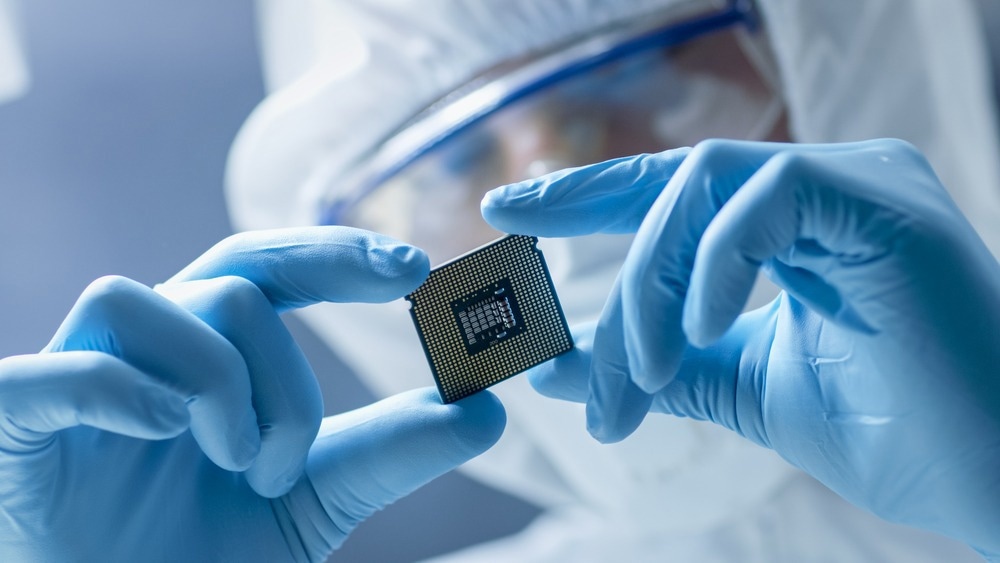Lab-on-a-chip is a class of devices that can revolutionize the natural working of a laboratory, with multiple laboratory techniques being integrated and automated in a system that fits into a chip of remarkably small size, up to a few centimeters.

Image Credit: Gorodenkoff/Shutterstock.com
Such an innovative approach can manipulate reagents on the microscale, enabling effects such as rapid heating and mixing to be used effectively while also reducing waste and exposure to dangerous chemicals. Additionally, the advancement of this technology through graphene in wet environments may progress the application of this device further.
Lab-On-A-Chip Devices
The revolutionary use of lab-on-a-chip technology has the potential to innovate the field of medicine, with the ability to shrink the working of an entire biochemistry lab to a device that is the size of a mobile phone or smaller. A portable scanner or reader, in addition to the chip, can utilize a tiny blood or bodily fluid sample to provide an instantaneous result and diagnosis of chronic disease.
The commercialization of this innovative technology has monumental benefits, such as providing diagnoses at an accelerated speed, with lower costs and potentially higher accuracy than current technology utilized in traditional laboratories.
These devices can be constructed with plastic and are engineered to comprise tiny channels, valves, and pumps. These elements aim to carry out techniques such as transporting, mixing and analyzing biological components, including proteins, DNA, and chemicals, for a particular testing outcome.
Benefits of Lab-On-A-Chip
The results of this innovative technology can be captured through images taken by a phone, which can then be sent off for interpretation by a specialist. This can be beneficial in remote areas and undeveloped countries, which lack appropriately trained laboratory technicians as well as expensive equipment and laboratory stock.
An FDA-approved lab-on-a-chip device currently available for use enables the screening of newborn blood, which aims to detect lysosomal storage disorders. Lysosomal storage disorders include a group of rare, inheritable metabolic diseases that occur as a result of enzyme deficiencies within the lysosome.
The severity of this condition can be fatal if left untreated; however, a large volume of newborn babies, including 100 million out of 137 million born annually, are not screened for this disease. Using a lab-on-a-chip device can significantly alter this statistic and allow early detection of this disease, resulting in subsequent treatment.
Graphene in Transistor Technologies
The development of a lab-on-a-chip device is dependent on an important building block of all electronic circuitry and even, arguably, the most important component when building digital and analogous electronics, consisting of transistors.
Additionally, the use of graphene within transistors aims to further progress the development of transistors to create innovative and revolutionary devices that advance the field of technology and medicine, especially when used in lab-on-a-chip devices.
Graphene, an allotrope of carbon, consists of a one-atom thick layer that is arranged in a hexagonal lattice and has many remarkable physicochemical properties that have increased its desirability for advancing many applications and fields.
How Does a Graphene Field Effect Transistor Work?
A graphene field effect transistor (GFET) is constructed with a graphene channel between two electrodes with a gate contact that is used to modulate the electrical response of the channel.
The exposure of graphene enables the functionalization of the channel surface as well as the binding of receptors to this area, ensuring the surface of the GFET channel is functionalized for a particular target of interest.
The binding of a target molecule to a receptor on the graphene surface results in the redistribution of electronic charge; this produces a change in the electric field across the FET channel, altering the electronic conductivity in the channel and the overall response of the device.
The use of graphene is beneficial due to its heat and electrical conductivity properties, and while similar FET devices have been constructed with silicon, these devices generate limited sensitivity as well as poor selectivity.

Image Credit: Production Perig
Novel GFET for Wet Environments
Interestingly, a newly developed graphene-based field effect transistor aims to further advance current technology by expanding its use to include effective operation in wet environments. This novel device was developed by Archer Materials and sought to integrate their GFET technology with on-chip microfluidics to enable multiplexing, allowing the parallel detection of multiple biologically relevant targets.
The latest development by this Australian-based company involves two main strategies: ensuring liquids are prevented from shorting the integrated circuit and acquiring electronic signals from the liquid, which is used as part of this innovative device.
This novel development that enables biological applications that work in liquids may be revolutionary for both technological and medical applications. It can be used as a sensing device for digitizing biologically relevant signals from target analytes of viruses or bacteria that can be present in liquid samples, producing an effective handheld diagnostic device.
The applications for this type of advanced technology, which utilizes graphene, include medical applications as well as other applications such as possible research into water-borne diseases.
The testing of water-based samples can be beneficial in remote areas in both developed and developing countries, with approximately two billion people globally that are using drinking water sources contaminated with feces.
Additionally, the versatility of lap-on-a-chip devices, which remove the pressure of expensive equipment and trained staff used within a traditional laboratory, allows a wider population to have access to a testing device for a range of critical applications, including disease detection and screening.
Future Outlook
While lab-on-a-chip devices may still be at the start of their journey, they hold significant potential for the future and may mark the beginning of a novel era for diagnostics. With many ubiquitous diseases being left undiagnosed and untreated, the use of a miniature device that is affordable and easy to use may alleviate the global disease burden.
More than 300,000 babies are born with sickle cell anemia annually and do not have access to medical care or testing equipment, resulting in premature death in infants under the age of 5.
The introduction of this type of device has the potential to save many lives for a multitude of diseases, which would be revolutionary for all populations within both developed and developing countries. Additionally, this device's continuous development through graphene to advance transistor technology may aid in advancing and disrupting the traditional methods of diagnosis on a global level.
References and Further Reading
Drinking-water (2022) World Health Organization. World Health Organization. Available at: https://www.who.int/news-room/fact-sheets/detail/drinking-water
Future of Medicine: Lab-on-a-chip devices starting to make an impact (2021) National Heart Lung and Blood Institute. U.S. Department of Health and Human Services. Available at: https://www.nhlbi.nih.gov/news/2021/future-medicine-lab-chip-devices-starting-make-impact
Graphene Field Effect Transistors for biological and chemical sensors (no date). Sigma Aldrich. Available at: https://www.sigmaaldrich.com/GB/en/technical-documents/technical-article/materials-science-and-engineering/organic-electronics/graphene-field-effect-transistors
Lab-on-a-chip. Nature news. Nature Publishing Group. Available at: https://www.nature.com/subjects/lab-on-a-chip
Sharma, B.K. and Ahn, J.-H. (2013) “Graphene based field effect transistors: Efforts made towards Flexible Electronics,” Solid-State Electronics, 89, pp. 177–188. Available at: https://doi.org/10.1016/j.sse.2013.08.007.
Disclaimer: The views expressed here are those of the author expressed in their private capacity and do not necessarily represent the views of AZoM.com Limited T/A AZoNetwork the owner and operator of this website. This disclaimer forms part of the Terms and conditions of use of this website.